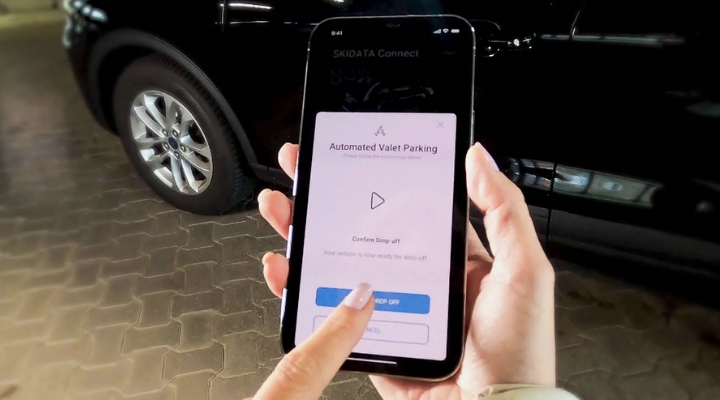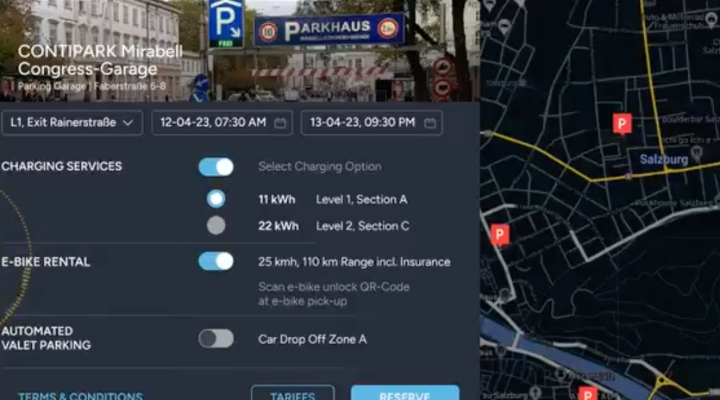Loading component...
Get up to speed on the mobility industry - our newsletter straight to your inbox!
Get up to speed on the mobility industry - our newsletter straight to your inbox!
SKIDATA’s Head of Solution Portfolio, Thomas Pühringer, explains the thinking (and the technology) behind the concept of Automated Valet Parking and Video Car Tracking, as the sector makes the huge leap from paper ticket-based services to artificial intelligence-powered mobility.
Parking, and particularly parking management, has undergone something of a transformation over the last couple of decades. From blindly looking in your car’s central console for some coins with which to pay for your ticket we then transitioned to the more innovative era of ticketless and barrierless parking. Now, though, we are entering an age where parking is an intrinsic piece of AI-Based Mobility puzzle.
How we interact with parking spaces is under increasing scrutiny – so if the technology exists that allows us to hand over the task of parking our car to an AI-powered solution, why would we not do it in a heartbeat? Especially if it was part of a suite of technology assistance designed to make our lives easier…
Intertraffic: In your presentation at our Amsterdam 2024 show SKIDATA described Automated Valet Parking (AVP) as the last stage of an evolution and part of a bigger AI-based mobility strategy. Could you expand a bit more on the ‘evolution’ part of that? The mobility transition has been the theme of the last two Intertraffic Amsterdams, so how does the evolution of parking from a ticket-based industry to an AI-powered industry fit into that picture?
Thomas Pühringer (TP): Let me go one step back. First we need to explain what are the fundamental technologies that enable automated valet parking, as we presented at Intertraffic. There are, of course, some misconceptions around the idea of AVP and most people have in their minds that automated valet parking is the car just parking by itself. However, for a number of reasons, that's not how it works in the concept we presented. The issue is that in many parking infrastructures there are a lot of angles where you can't see what's happening, for example when cars are going up and down ramps, there's pedestrians walking around and there could be also risks arising from a car that's been parked and that wakes up again and starts driving.

This is why the AVP2 standard-compliant solution that we intend to launch is based on Internet of Things (IoT) technology, so the parking infrastructure is able to communicate with and remotely control the car. The Video Car Tracking system transforms parking garages to operate through a strategic deployment of cameras. This network of cameras captures and analyses video streams in real-time, facilitating robust vehicle and object recognition.
In many parking infrastructures there are a lot of angles where you can't see what's happening, for example when cars are going up and down ramps, or where there's pedestrians or risks arising from a car that's been parked but wakes up again and starts driving to the exit
Intertraffic: So the technology already exists and it means that there is no need to build new parking infrastructures, it can be integrated into existing car parks…
TP: We have the technology that enables us to employ camera vision and object identification and interpretation. We see a lot of stuff that's happening in and around the car and we can establish an IoT connection with the car to then remotely control it to the right place with these technologies. We can create value for operators and end users already. You can identify and re-identify the car at multiple places in the parking garage, so you can do a number of interesting things.
First of all, license plate recognition technology at the entry point is not always super-reliable. However, if you could re-identify that same car at different places in the parking garage and get another chance of linking the object and the license plate in different positions, then you can increase the entry and exit match rate and with that increase the chances that it actually works without a glitch for the end users getting in and out. So that's a simple use case.

Intertraffic: And it works similarly for floor-specific car-counting and therefore space calculation?
TP: So as an operator, you want to know how many cars are in your garage and then how many are on which floor. With loops there can be missed vehicles simply because somebody moved a shopping cart over the loop. As an operator you're not selling the amount of parking spaces that you could be, but with object recognition, with those cameras, we can do much more accurate counting. We can also identify if a car is parked badly over two spaces or if it’s a diesel car parked in an EV charging space - well, you could apply a special tariff for that. These are just some examples where we can have a parking facility that uses the AI engine: more cameras create value and at the same time they become AVP-ready.
We can also identify if a car is parked badly over two spaces or if it’s a diesel car parked in an EV charging space - you could apply a special tariff in those cases
Intertraffic: Does Automated Valet Parking require a certain level of connectivity with which to communicate? Presumably if you have a 1999 Citroën Xantia you aren’t going to be able to use the service?

TP: The interesting part of it is a lot of it is possible technically, but not a lot of it is possible commercially. The technology we are talking about is comparatively cheap because it’s compatible with cars that are quite standard model. You don’t need thousands of sensors and a high-powered AI processor, we're talking a standard car that has the already mandatory acceleration assistance, lane-keeping assistance and standard interface connection. Most modern cars already have a SIM card and some connection to the Internet. For the operators, we're talking standard, quite cheap security cameras and then a single, quite powerful computer with the AI capability and that's it. I think that is the key for it to even have a chance to go mass market.
We need to have a solution where the car can get in and out, and that's where the combination of IoT communication with the infrastructure comes in quite handy. The car can say “I'm here now, let me in.” There will be a handover of the automated driving car to the automated parking system and they can work together.
Most modern cars already have a SIM card and some connection to the Internet. For the operators, we're talking standard, cheap security cameras and then a single, quite powerful computer with AI capability and that's it. I think that is the key for it to even have a chance to go mass market.
Intertraffic: At a recent parking event there was much discussion about Parking as a Service (PaaS) being an intrinsic part of the mobility transition. Do you see AVP as an intrinsic part of PaaS?

TP: I do, yes. I think if you look at what you want to offer to the end user and how you can organize it, then PaaS or MaaS can be a very interesting piece of it. However, it's very important that different parts of the systems can talk to each other, so data exchange standards will become much more important. Security standards will become much more important because if you no longer have isolated systems that are enclosed there's also the risk of security threats. Ultimately, I can drop off my car at the bus or train station, ideally for last mile transport, without having to think much about the parking part or driving into the garage part. I think this is a great value proposition and can greatly contribute to much better end-to-end solutions.
Intertraffic: Parking is becoming increasingly intelligent, seamless and user-centric. The parking sector, automotive sector and ITS sector are all ready for this step as this has been talked about for a long time, but do you think drivers are ready for this? In modern society everyone seems to want something in return before they will change their habits, even if it’s something that will ultimately help them
TP: I personally think drivers are ready. Let’s be honest, nobody really enjoys parking in a parking garage. The whole experience from having to pull a ticket from a machine, having the feeling of being closed in by going underground into often narrow and not perfectly lit spaces and then finding your way out again… There are so many parking pain points for the end user. It's great for the operator because it's the ultimate money-making machine and all the systems have been historically designed to make sure the operator can make their money. However, it's not been particularly designed to be a great experience for the end user.

The idea of handing my car over to somebody is quite critical to a European-minded person. I read a very interesting study where they've surveyed quite a few people and interestingly, when asked, a lot of people would rather hand their car over to AI than a human
The one thing that is not as common in Europe as it is in the US or Australia is valet parking. The idea of handing my car over to somebody is quite critical to a European-minded person. I read a very interesting study where they've surveyed quite a few people and interestingly, when asked, a lot of people would rather hand their car over to AI than a human. SKIDATA is not just responding to changes in parking technology - we are actively defining them. For parking operation managers, adopting these AI-powered solutions is essential for thriving in an increasingly automated landscape.